The 2025 guide to the best community platforms
Communities are as unique as the DNA of its members.
More community builders like you are realizing that bigger isn’t always better. Instead of trying to be “everything to everyone” on algorithm-driven social platforms, they’re creating content and connections that bring people together, from online courses to organizing IRL meetups.
Why? Because real engagement happens in focused communities, not in the endless scroll of social media. The proof is in the stats. According to respondents in our 2025 Community Trends Report, one community member is worth 234 social media followers.
But building and sustaining your community requires the right tools, including the most important one—a community management platform. There are so many options out there that you can find yourself in analysis paralysis.
In this post, we’ll help you understand the options available and what you need to consider when choosing a community platform. We will also share the best options for your community’s specific needs.
What defines a community platform in 2025
Before we get to your ideal community platform, let’s define what it actually is and should do for your business and the differences between social media and community platforms.
👉🏼 A community platform is a digital space where people gather to connect, share, and collaborate around a shared interest, goal, or identity. For community builders, it’s a place where you can manage all your community functions.
It’s important to note that just because a community platform is digital doesn’t mean your community can’t meet in the real world. Many community platforms offer the ability to organize meetups and other in-person gatherings.
The evolution of community platforms
Online communities have come a long way from the early days of dial-up internet. What started with bulletin board systems (BBS) and email listservs evolved into AOL chat rooms and early online forums like phpBB and vBulletin.
Social media platforms like Twitter (sigh, X) and Facebook introduced new ways for users to connect and share (thanks for the memes), but they had limitations as true community platforms.
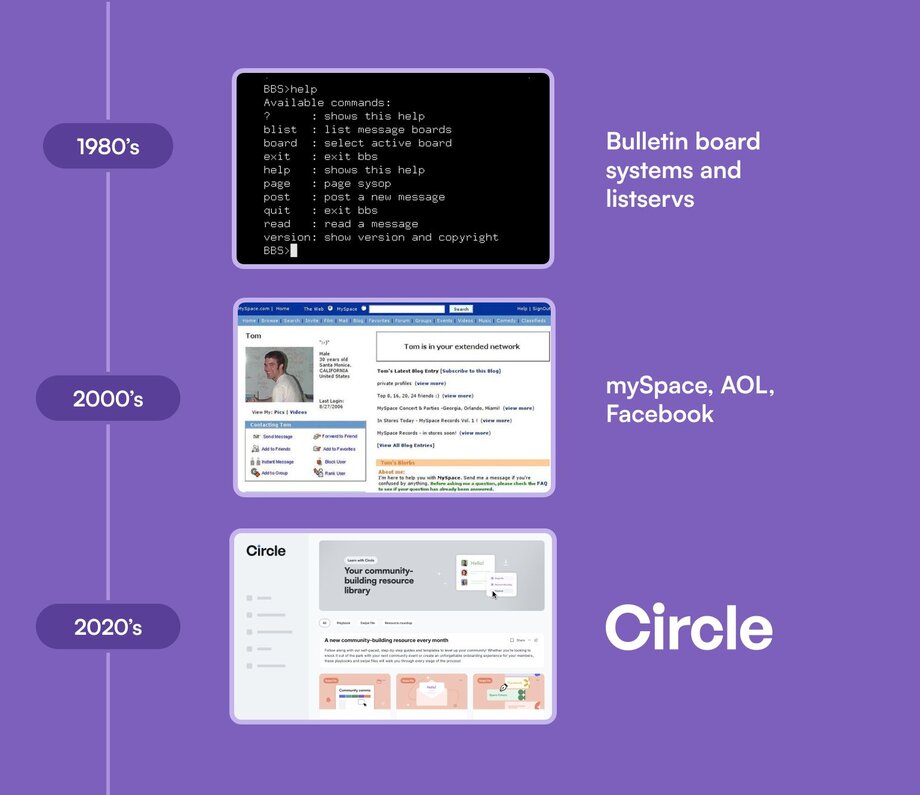
Today, purpose-built platforms like Circle give creators and businesses full control over their communities. They offer seamless engagement, monetization, and integrations without relying on algorithms.
Social vs. community platforms
While social platforms like Facebook and Myspace were the first digital tools to bring people and communities together online, andInstagram, YouTube, and X now have community features–they lack the dedicated focus of a community platform.
Standalone community platforms are specifically designed to foster deeper interactions, deliver exclusive content, and drive member-led discussions.
Let’s look at four ways community platforms offer you a better foundation for your community:
- 🛂 Control and ownership. Communities built on social media platforms rent the space from someone who sets the rules and policies and can change them at any time. With a community platform, you own the space, the content, and the experience. You decide the rules, the branding, and how your members interact.
- 🕵️♂️ Data privacy. If protecting member privacy is a priority, a dedicated community platform is the better choice. Community platforms put privacy and security in your hands. On social media platforms, user data is often collected, analyzed, and monetized through advertising.
- 🎉 Engagement quality. Social media thrives on quick interactions—likes, shares, and fleeting comments that keep people scrolling. Community platforms are built for meaningful conversations and deeper relationships. Members join because they want to engage, not just passively consume content.
- 💰 Monetization options. On social media, monetization is often tied to advertising, sponsorships, or brand partnerships—methods that depend on follower count and engagement rates. Community platforms offer more control over revenue, with options like paid memberships, exclusive content, and event ticketing.
👉🏼 If you’re looking to foster real connections, protect member data, and build a long-term business, a community platform offers more stability and control than social media ever could.
How to choose the right community platform for you
Choosing a community platform is an investment and a research project all in one–as many business decisions are.
We always like to go back to the tried and true method of making a pros and cons list. (Spoiler alert: you’ll see that in our list of the best community platforms later.)
Focusing on what matters most to your community and your long-term goals is key. The right community platform should have the tools and flexibility to drive engagement, manage content, and scale as your community grows.
What are the must-have features of a community platform? ⭐️
The best community platforms balance flexibility, engagement, and monetization tools to help creators, solopreneurs, and founders build sustainable, thriving communities.
💬 Members today expect more than a forum. They want personalized experiences and spaces where they feel valued and connected.
Here are a few must-have features in a community platform:
- Member management tools that let you onboard, segment, and direct members easily while controlling access and permissions.
- Content tools that support everything from discussions and blog-style posts to multimedia content libraries and live events.
- Customizable spaces that let you create different sections, groups, or forums within a single platform for better organization.
- Discussion and engagement tools that provide real-time chat options to inspire meaningful conversations.
- Event and live streaming capabilities for hosting webinars, AMAs, or other networking events.
- Monetization and subscription options like built-in payment processing for memberships, courses, or exclusive content.
- Integration capabilities to let you connect to a CRM, email marketing, analytics, or any other third-party platform like Zapier.
- Mobile app so your members can have a seamless experience wherever they are.
What are some nice-to-have features of a community platform? 🫶🏼
While must-have features define the foundation of a community platform, these nice-to-have features might include one that you have your heart set on, like gamification.
Here are a few nice-to-have features to keep an eye out for when looking at community platforms:
- AI-powered engagement and moderation tools that suggest content, flag inappropriate behavior, and personalize member interactions.
- Workflow automation tools that streamline repetitive tasks, automate member onboarding sequences, and coordinate cross-platform communications to reduce admin workload.
- Gamification and badge systems to reward members, boost engagement, and incentivize participation.
- White-labeling and branding options that let you customize your community’s look and feel.
- Built-in course creation tools that include a learning management system (LMS) for hosting structured educational content.
- Advanced analytics and insights that provide deeper tracking of member behavior, helping admins optimize the community experience.
(Unsurprisingly, Circle has all of these and more.)
Seven questions you should ask before selecting a community platform
A community platform can have every feature you’ve ever dreamed of, but it won’t be the right one if it doesn’t meet your specific needs. When you’re evaluating the options, ask yourself:
1️⃣ Is it easy to use? From onboarding experiences to day-to-day use, your community needs to be easy to navigate.
2️⃣ Will people use it and engage? Different platforms cater to different needs—whether it’s branded communities, private memberships, or education-based groups.
3️⃣ Can I set up flexible payments and paywalls? Your community is your passion and your business. Make sure the platform you select has the payment options that best suit your goals.
4️⃣ Will my members keep coming back? You need consistent and creative ways to drive members back into the community, from automation tools to workflows.
5️⃣ How do I keep my community safe? No one wants to stay in a community where they don’t feel they can be their authentic selves.
6️⃣ Do I need multiple platforms or can I do it all in one? Sure, you could connect a bunch of platforms together, but wouldn’t it be nice to have one tool to rule them all.
7️⃣ How do I measure the success of my community? We’re not just talking engagements and analytics—though they are super important. Consider how the platform helps you generate revenue (through memberships, courses, sponsorships, etc.) and whether it justifies the cost.
👉🏼 The right community platform should empower you to build meaningful connections, provide value to your members, and scale as your needs evolve. By considering your must-have features and long-term goals, you can choose the best community platform that grows with you—not one that holds you back.
Top 13 community platforms compared
1. Best overall community platform: Circle
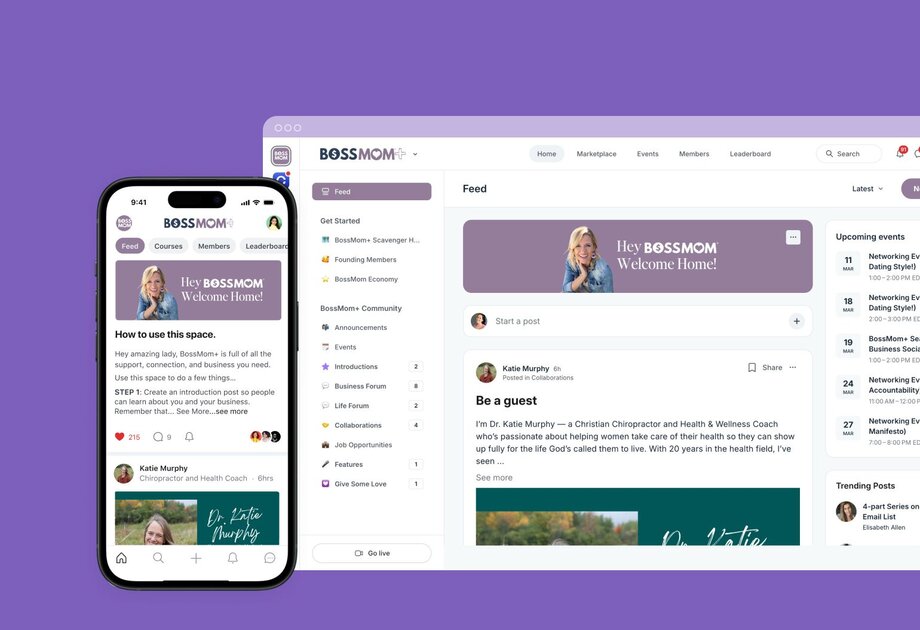
Circle is a dynamic community platform for creators, educators, and businesses looking to create thriving online spaces. Yes, we’re biased, but Circle is packed with engagement, monetization, and collaboration tools that let you design the best, seamless, member-first experience—in one place.
Key features:
- Branded community spaces for discussions, chats, events, resources, and content sharing.
- Flexible monetization tools for paid memberships, courses, or exclusive content.
- Built-in communication tools and features like automated community digests, community AI, and email marketing.
- Integrations with Zapier, Google Analytics, and more for seamless workflows.
- Mobile app for on-the-go member engagement.
- Gamification features to keep your members coming back for more.
- White-label options for your very own branded app via Circle Plus.
Pricing:
Plans start at $89/month for core community features, $199/month and up for additional features. Circle also offers a 14-day free trial on most of our plans!
Best for:
Creators, entrepreneurs, and educators building online community businesses who value engagement, retention, and monetization options and features.
Users say:
👍🏼 “We wanted to get off of Facebook, so we shut down our 75k group and moved to Circle. I opted to get my own BossMom+ app which they manage. We got rid of all of our course management or community tools and house it all in one place on Circle. It's made our life so much easier, but more than that it has allowed us to brand our own space that we own which has really helped the brand.”
🤔 “Some advanced analytics features are missing, which would help community managers track engagement more effectively.”
Pros:
- User-friendly interface with customizable branding.
- Strong monetization options, including tiered memberships and courses.
- Excellent engagement tools like live streams, chat, and event hosting.
- Active support community and helpful resources for creators.
- Product development is light-years ahead of competitors (with a focus on launching customer feature requests)
Cons:
- Limited analytics compared to some competitors.
- Pricing can be high for new community builders getting started.
- Limited analytics (but we’re making them better!)
2. Best for professional communities: Slack

We don’t want to give you a flashback to high school “if this, then that” exams, but Slack is to office chat as Kleenex is to tissues. Originally built for workplace communication, Slack’s user base has grown to include professional communities for networking, knowledge sharing, and discussions.
⚠️ Heads-up: Slack's free plan limits message history, so communities risk losing access to older conversations. For example, Superpath faced the possibility of losing 800,000+ messages from 23,000 members unless they upgraded to an enterprise plan at $26,000/month. 😱
Key features:
- Real-time messaging with channels, threads, and direct messaging.
- Extensive integrations with workplace tools like Google Drive, Notion, and Trello.
- Searchable archives (on paid plans) for retrieving past conversations.
- Voice and video call capabilities for quick team check-ins.
- Workflow automation for streamlining notifications and updates.
Pricing:
There is a free plan available with limited features, including the number of messages that can be saved and accessed. Paid plans start at $8.75/user/month, and higher tiers are required for full message history and advanced features.
Best for:
Professional communities, industry networks, and teams that prioritize real-time discussions over structured content.
Users say:
👍🏼 “Slack organizes online office space where teams are connected through chat and can work together. It is very easy to use, and we can create many channels for specific topics, projects or teams. We can direct private messages to any people in the workspace. Many automation are available. We can make smooth voice & video calls smoothly.”
🤔 “The possibility of notification overload is what I find objectionable about Slack. When you're part of a number of channels or teams, it can feel like you're constantly getting pings, even when you're not actively engaging in a conversation. Particularly if you're trying to concentrate or if you're working in various time zones and things are happening while you're offline, it could be a bit much.”
Pros:
- Easy to get started.
- Makes it simple for teams to get connected and share updates.
- Integrates with hundreds of other tools.
Cons:
- No built-in community management features.
- Pricing is on a per-user basis.
- Can be expensive as a community grows.
🔄 Thinking of switching from Slack?
Many communities outgrow Slack due to its limited content organization, lack of built-in monetization tools, and expensive message history retention. If you’re considering making the move, check out this “Slaxit” migration story from Modern Fertility or watch this video walkthrough on how Everything Marketplaces successfully migrated from Slack to Circle.
3. Best for alumni networks: Hivebrite

Hivebrite is a feature-rich community platform designed primarily for alumni networks, professional associations, and nonprofit organizations. It offers a structured environment for connecting members, managing events, and fundraising, making it a strong choice for communities with a clear organizational purpose. However, while Hivebrite provides powerful tools, its rigid structure and pricing may not be the best fit for every type of community.
Key features:
- Branded member portals and an advanced member directory with search filters
- Event management tools for hosting virtual or in-person events with ticketing and RSVPs.
- Fundraising and donation management to support nonprofit and alumni-driven initiatives.
- Content management system for news, updates, and private discussions.
- White-labeling and customization to align with branding and organizational identity.
- CRM-style tools for managing relationships, tracking engagement, and automating workflows.
Pricing:
No publicly available free trial. Contact them to get pricing details.
Best for:
Universities, professional associations, and nonprofits looking for an all-in-one platform with event management, fundraising, and CRM capabilities.
Users say:
👍🏼 “Hivebrite's back office allows clients to customize so many aspects of their users' interface—from the site map's design to branding elements and content/copy. This customization capability results in a platform that can look, read, and feel unique to the client's use case. It's like "next best thing" to building software yourself, but when you use Hivebrite you don't have to carry the burden of the product's development on your own shoulders.”
🤔 “The downside to any big platform with lots of clients is that they can't implement every request from clients, particularly ones that may be niche. It can be frustrating not knowing whether a request that's deemed feedback will be actioned or not.”
🎉 Fun fact: Circle has launched 200 user-requested features in Circle in the past 4 years.
Pros:
- Robust networking tools for professional connections.
- Scalable for large organizations and enterprise use.
- Detailed analytics for tracking community health.
Cons:
- High price points may be prohibitive for smaller organizations.
- Limited customization options.
- Limited options for smaller communities or startups.
4. Best for network-based communities: Mighty Networks
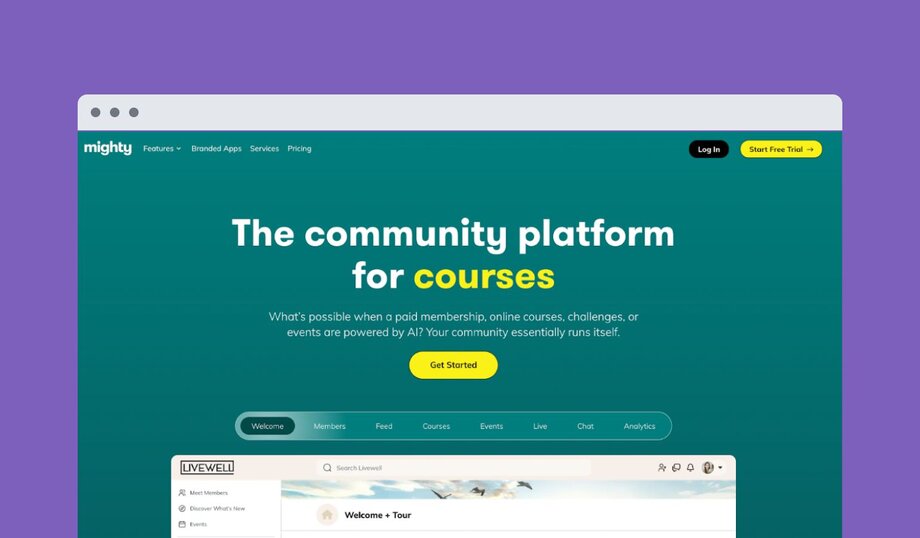
Mighty Networks is a community platform designed for highly interactive, network-driven communities. With a focus on member connections, courses, and content sharing, it offers an all-in-one solution for those looking to drive engagement without relying on external social media platforms.
Key features:
- Branded community spaces that function like a private social network for discussions, content, and networking.
- Built-in course creation tools that let community leaders offer structured learning experiences.
- Event hosting capabilities for live and virtual events.
- Mobile app support for on-the-go engagement with members.
- Monetization options, including paid memberships, exclusive content, and online courses.
- Networking features that encourage peer-to-peer connections within the community.
Pricing:
Mighty Networks offers a 14-day free trial. Plans with basic community features start at $39/month. Higher-tier plans with courses and memberships start at $119/month.
Best for:
Creators, coaches, and entrepreneurs looking to build a network-driven community with built-in course creation and content monetization tools.
💡 Circle vs. Mighty Networks: Which one is right for you?
While both platforms offer robust community-building tools, they are not like us when it comes to flexibility, branding, and engagement features. Mighty Networks is a leader in creating a network-driven experience, but Circle offers more customization, engagement tools, and monetization flexibility for long-term community growth.
What Circle users are saying:
👍🏼 “I’ve just switched over from using MN to host my community and it’s such a relief to be here in Circle - it’s so simple and clean! I’m trying to help reduce the noise, overwhelm and distraction in people’s lives so how the platform looks and feels is really important to me. That’s why I don’t use social media for this.”
Users say:
🤔 “The only downside I see to Mighty Networks is the upfront learning curve. We got around it by hiring a third party consultant to set up our site. Once the structure was set, it was easy for us to add the content, images, and other bells and whistles.”
Pros:
- Simple setup for private communities.
- Integrates well with third-party tools.
- White-label branding is available on higher-tier plans.
Cons:
- Limited integrations and no API to connect with other platforms.
- Cluttered navigation makes it hard to find what you need.
- Not as scalable for large, enterprise-level networks.
5. Best for course-centric creators: Kajabi
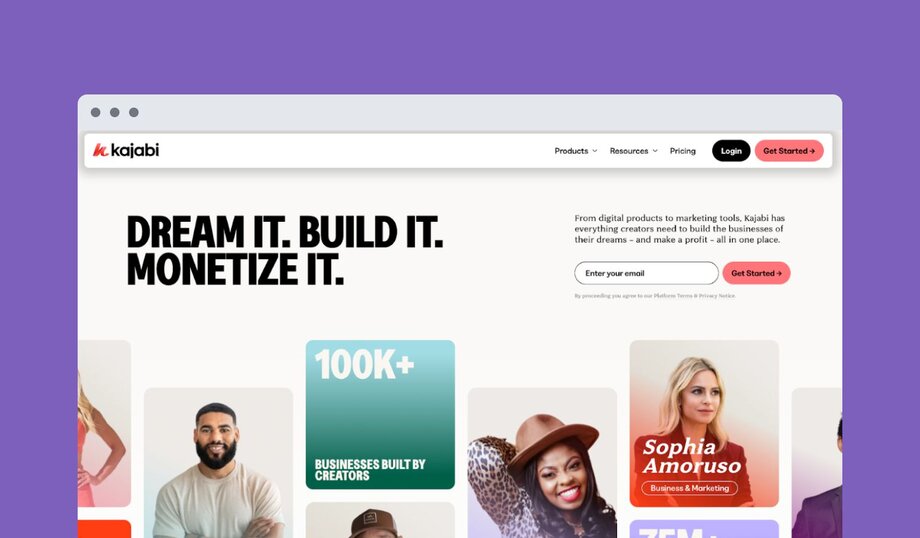
Kajabi is an all-in-one platform designed for creators who focus on courses, coaching programs, and digital products. While it includes community-building features, its primary strength lies in content delivery and monetization. If your community is centered around education and structured learning experiences, Kajabi offers a seamless way to integrate courses with memberships and engagement tools.
Key features:
- Course creation tools for building structured learning programs with videos, quizzes, and drip content.
- Community spaces that allow members to engage and interact within course-based groups.
- Built-in monetization tools for selling courses, memberships, and coaching services.
- Marketing automation features like email sequences, sales funnels, and landing pages.
Pricing:
Kajabi offers a 14-day free trial. Plans start at $149/month, with higher tiers offering advanced automation and marketing features.
Best for:
Course creators, educators, and coaches who want to build an online learning business with integrated community features.
🔄 Need more flexibility in your community?
While Kajabi excels at delivering courses, its community features are limited compared to platforms like Circle. Many creators integrate Kajabi with Circle to get a powerful learning platform with a highly engaged, customizable community.
Users say:
👍🏼 “Easy to implement all in one platform for courses, website, email, shopping cart, and way more. It has tagging, email sequences, quizzes, podcast, blog, video hosting, and incredible flexibility. The end result is beautiful and fast. Customer support is responsive.”
🤔 “It was not as friendly for exploring their other features, I couldn't do it myself we needed a team of experts to come in and design the layout.”
Pros:
- All-in-one platform for courses, memberships, and digital products.
- Built-in email marketing, automation, and sales funnels.
- Strong monetization tools, including subscriptions and one-time payments.
Cons:
- Expensive compared to other platforms, with pricing starting at $149/month.
- Community features are secondary to course delivery.
- Limited engagement tools for discussions and real-time interaction.
6. Best for coaching communities: Skool

Skool is a community platform for coaching groups and course creators who want to keep things simple. It combines online courses, a discussion forum, and gamification into a single platform. While its structured approach makes it easy to set up and manage, Skool lacks flexibility in customization, branding, and integrations, limiting its long-term scalability for growing communities.
Key features:
- Simple, structured community layout with a focus on ease of use.
- Built-in course hosting for online education and training programs.
- Gamification features like leaderboards to drive engagement and participation.
- Single pricing plan with no add-ons or upgrade tiers.
- Limited integrations compared to other platforms, making it less flexible for advanced automation.
- Basic customization options with restricted branding capabilities.
Pricing:
No free trial, but Skool offers a 14-day $1 trial. Flat rate of $99/month, including all features with no tiered pricing.
Best for:
Coaches, course creators, and mastermind groups looking for a straightforward, all-in-one platform.
Pros:
- Simple, user-friendly design that’s easy to navigate.
- Built-in gamification with leaderboards to boost engagement.
Cons:
- Limited customization options—branding and layout flexibility are minimal.
- No advanced integrations with third-party tools.
7. Best for gaming and crypto communities: Discord

Discord is a real-time chat platform originally built for gamers. It has since expanded into the crypto, Web3, and creator communities. With voice channels, text chat, and customizable servers, Discord excels at fast-paced discussions and live engagement. On the downside, its structure can be chaotic for larger communities, and it lacks built-in monetization and long-term content organization.
Key features:
- Real-time voice, video, and text chat for instant communication.
- Customizable servers with roles and permissions to manage member access.
- Live streaming and screen sharing for events, gaming, and discussions.
- Bot integrations for automation, moderation, and engagement tools.
- Threaded discussions to help manage ongoing conversations.
Pricing:
Discord Nitro starts at $9.99/month for additional perks like higher-quality streaming and larger file uploads. Discord Nitro occasionally offers limited free trials.
Best for:
Gaming communities, crypto and Web3 groups, and teams that prioritize real-time connection.
Users say:
👍🏼 “It is a great app for building and engaging with a community and being productive at the same time. There is no dearth of features to improve engagement with your audience be it in chats or the voice channels.”
🤔 “Sometimes the notifications can be overwhelming, especially on busy servers. It can also be tricky to manage settings across different channels.”
Pros:
- Cross-platform support on MacOS, Windows, Android, and iOS.
- Many core features are free.
- Well-documented API allows for integrations into third-party platforms.
Cons:
- Chaotic structure for large communities—lack of organized discussions.
- No built-in monetization tools, requiring third-party solutions.
- Limited long-form content features (no blogs, articles, or structured posts).
8. Best affordable option for broad reach: Facebook Groups
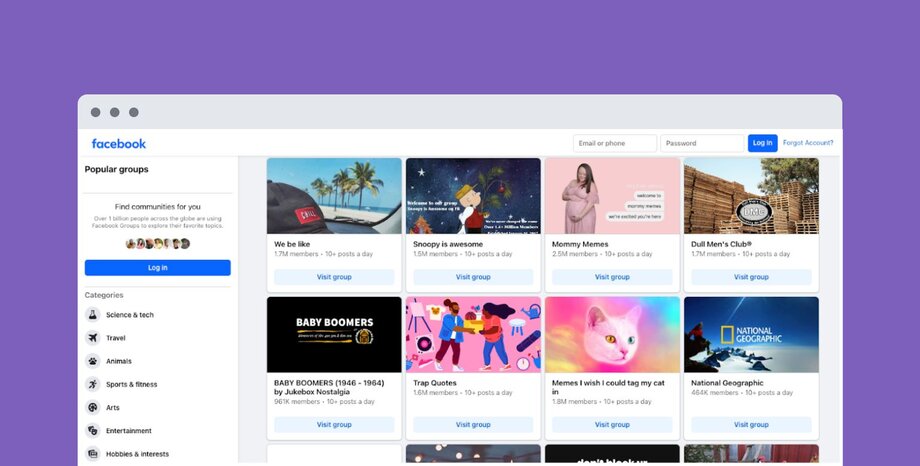
Facebook remains a popular choice for community building thanks to their accessibility and built-in audience. With over three billion users, Facebook provides instant discoverability and easy setup. The downside? Its algorithm controls visibility, limiting reach, and community owners don’t truly own their member data.
Key features:
- Instant visibility with Facebook’s massive user base.
- Simple discussion boards with posts, comments, and reactions.
- Basic event hosting for virtual or in-person meetups.
- Limited monetization—no direct paid memberships or courses.
- No customization or branding options outside of group name and cover photo.
- Algorithm-controlled reach—not all members see every post.
Pricing:
Free to create and manage, but monetization options require third-party tools.
With Facebook, you are the product. That’s bad. The good news? Facebook Groups are free.
Best for:
Businesses, creators, and hobbyist groups that want an easy, no-cost way to start a community with broad social media reach.
🔄 Looking for an alternative?
Many communities that start on Facebook Groups quickly outgrow its limitations—especially when engagement, monetization, and content ownership become priorities. See how you can be like Exit Five and successfully move your community from Facebook to Circle.
Users say:
👍🏼 “I love that I can continue to develop my online community, stay connected, and provide and allow feedback. Our online community continues to grow, and Facebook Groups continue to be a wonderful effective way to communicate with one another.”
🤔 “Within Facebook Groups, there may be individuals that spam the group with unnecessary messages and information. This has occured when rules have not been explicitly implemented or put-in-place for the entirety of the group. Unfortunately, when this happens, it can defeat the purpose of the groups, and may cause disagreements to occur amongst the participants.”
Pros:
- Free and easy to set up with instant access to a massive audience.
- Built-in event creation and live streaming tools.
- Organic discoverability within Facebook’s ecosystem.
- Simple moderation tools for managing members and posts.
- Mobile-friendly with push notifications for members.
Cons:
- Limited control—Facebook owns your data and can change algorithms anytime.
- No direct monetization options for paid memberships.
- The algorithm limits visibility—members may not see all posts.
- Lacks advanced community engagement tools beyond discussions and posts.
- No customization beyond basic group branding.
9. Best for learning communities: Disco

Disco is a learning-centric community platform for cohort-based courses, online academies, and professional learning networks. It offers built-in course creation, live learning experiences, and member networking, making it a solid choice for education-driven communities.
Key features:
- Structured course delivery with built-in learning modules.
- Live event hosting for interactive lessons and discussions.
- Member networking tools for peer collaboration and mentorship.
- AI-powered engagement to enhance learning experiences.
- Limited flexibility for non-learning-focused communities.
Pricing:
14-day free trial, and then plans start at $359/month for up to 1,000 members.
Best for:
Educators, cohort-based course creators, and professional learning networks.
Users say:
👍🏼 “What we appreciate most about Disco is its ability to bring multiple functionalities into one platform without compromising on ease of use. It has streamlined our operations, enhanced communication, and fostered a stronger sense of community.”
🤔 “It's still an early-market product, and while this has advantages, it also means that not everything is as holistically integrated as it will come to be over time.”
Pros:
- Strong networking tools for peer collaboration.
- Cohort-based learning experiences for interactive education.
- Integration with business tools like Zoom and Slack.
Cons:
- Higher price point compared to other community platforms.
- Limited flexibility for non-learning-based communities.
- Not ideal for real-time chat and casual discussion.
10. Best for brand communities: Bettermode
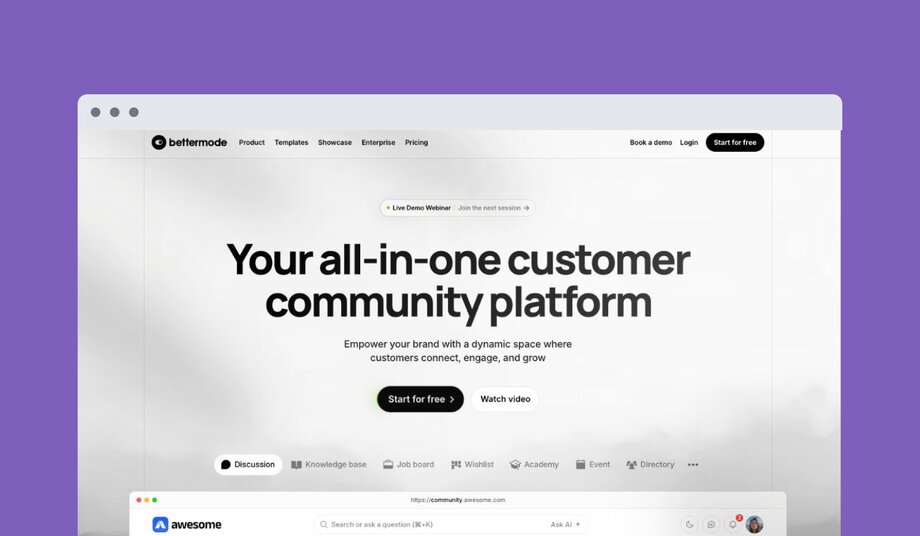
Bettermode is a community platform designed for brands and creators looking to engage customers, offer self-service support, and build long-term relationships. It integrates well with customer support tools, making it a strong fit for businesses that want to create user-driven knowledge bases or product-focused communities.
Key features:
- Customer self-service support with Q&A forums and discussions.
- Integrations with CRMs and help desk software like Zendesk.
- Moderation and analytics tools to manage customer interactions.
- Limited real-time engagement compared to community-first platforms.
Pricing:
A free starter plan is available. Pro plan starts at $49/month.
Best for:
Brands and businesses looking to build customer-driven support or product communities.
Users say:
👍🏼 “Helpful templates to get you started, then very easy to customise and make our own. Some easy to follow articles and videos to help us make the most out of Bettermode.”
🤔 “Community development can be demanding - today's community engagement extends across other platforms as well, you cannot expect it all to take place in your spaces - it would be great for Bettermode to offer some training in developing community across platforms - wherever your people are living online.”
Pros:
- Built-in CRM and integrations with help desk software.
- Custom branding and white-labeling options.
- Advanced analytics and insights for measuring engagement.
Cons:
- More suited for businesses than individual creators.
- Requires some technical knowledge to set up properly.
- Lacks gamification features for boosting engagement.
11. Best for educational content: Thinkific
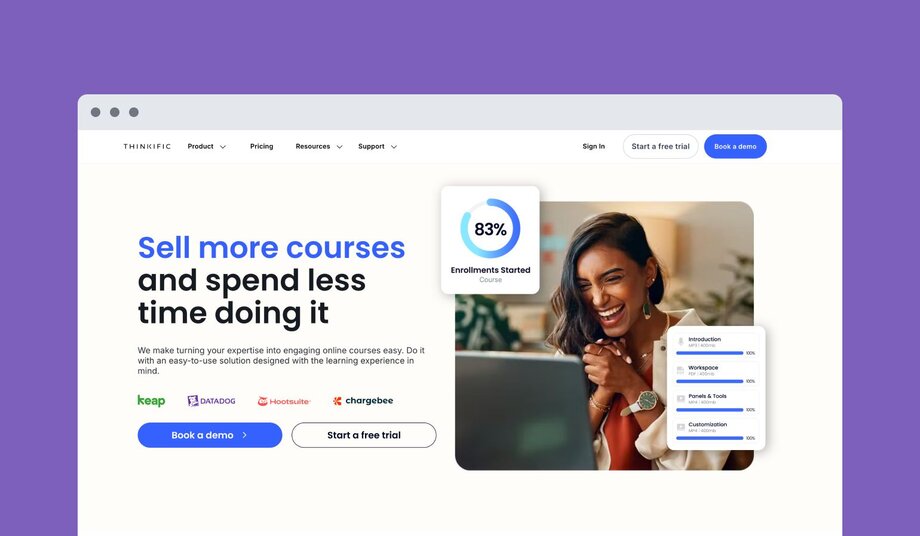
Thinkific is a well-established learning management system (LMS) for course creators who need structured lesson plans, quizzes, and certification tools. Thinkific includes community features, but they are secondary to its course delivery features.
Key features:
- Course creation tools with video, quizzes, and progress tracking.
- Basic discussion forums for student engagement.
- Payment processing for selling courses and memberships.
- Lacks advanced community engagement compared to Circle or other community-first platforms.
Pricing:
Thinkific has a 14-day free trial. Starts at $36/month, with advanced plans at $74/month and $149/month.
Best for:
Course creators who want a structured learning platform with basic community features.
Users say:
👍🏼 “Thinkific has everything you need in a Learning Management System or Learning Business Solution. It has tools and integrations for small or enterprise businesses.”
🤔 “Some advanced features will require knowledge of APIs and webhooks and even in-app functionality might only be possible through third-party paid apps. Although, the flexibility to extend it's functionality is a nice feature.”
Pros:
- Great course creation tools with quizzes and certifications.
- Custom branding for a professional learning experience.
- Multiple monetization options, including one-time payments and subscriptions.
Cons:
- Limited community-building features beyond basic discussions.
- Higher-tier plans are needed for advanced features.
- Focused more on course delivery than social interaction.
12. Best for digital product creators: Podia

Podia is an all-in-one platform designed for selling digital products and courses. It provides a simple way for creators to monetize their audience without needing external tools. Creators use Podia as an all-in-one solution to run their website, online store, and email marketing.
Key features:
- One-stop shop for courses, digital downloads, and memberships.
- Built-in email marketing and sales tools.
- Basic community features, but lacks deep engagement tools.
Pricing:
Podia has a 30-day free trial. Starts at $39/month, with advanced features at $89/month+.
Best for:
Digital creators looking for an easy way to sell courses, memberships, and digital products in one place.
Users say:
👍🏼 “My current and potential clients can find everything they need on my Podia site. I can update my website, interact with my community, add new products, track email campaigns, and view audience activity—all from a single platform.”
🤔 “It's hard to personalize your sales pages as their editor is limited. That would be great to have more options of styling and also add media easier like timers etc.”
Pros:
- All-in-one platform for selling courses, memberships, and digital downloads.
- Simple and beginner-friendly interface.
- Built-in email marketing and sales tools.
Cons:
- Limited community engagement tools beyond content access.
- No real-time chat or live event hosting.
- Basic customization compared to other platforms.
- Lacks gamification features to boost engagement.
13. Best for video-first communities: Swarm
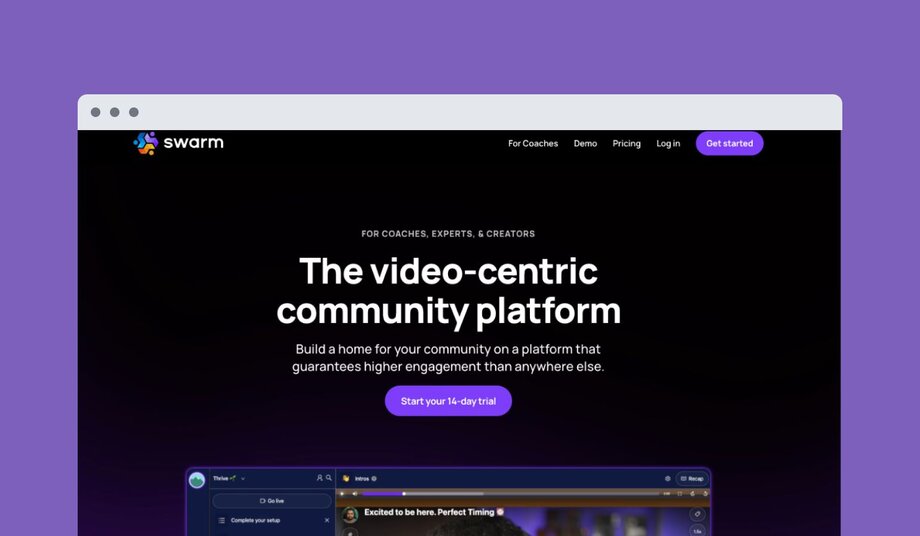
Swarm is a video-first community platform designed for real-time engagement, live events, and dynamic face-to-face interactions. It provides an immersive space where members can connect through live video rooms, host interactive discussions, and participate in virtual events without the barriers of traditional text-based forums.
Key features:
- Real-time video rooms for community engagement.
- Live events and networking spaces.
- Limited discussion tools outside of video interactions.
Pricing:
14-day free trial available. Starts at $39/month for one space and 25 users.
Best for:
Communities that thrive on video-based communication and live interactions.
Pros:
- Great for networking and mastermind-style communities.
- Provides a more personal, face-to-face engagement experience.
- Unique approach compared to text-heavy community platforms.
Cons:
- Lacks structured content and long-form discussion tools.
- Limited integrations with third-party business tools.
- Requires strong internet connections for smooth video interactions.
14. Best for fan-based communities & experts: Patreon

Patreon is a membership platform designed for creators, influencers, and experts who want to monetize their work through a direct supporter-based model. It allows artists, writers, podcasters, and other content creators to offer exclusive content, behind-the-scenes access, and special perks to their most dedicated fans.
Key features:
- Membership tiers with exclusive content access.
- Recurring revenue model for creators.
- Limited engagement features beyond content delivery.
Pricing:
Creating a Patreon account is free. Unlike other platforms, Patreon’s pricing is based on a percentage of your revenue per user. Pro starts at 8% of the income you earn on Patreon. Premium is 12%.
Best for:
Creators, artists, and influencers who want to monetize exclusive content through subscriptions.
Users say:
👍🏼 “My favorite feature is the exclusivity of it all. Only paying members have access to your content, which definitely elevates your content to premium levels.”
🤔 “When you provide evergreen content, it's hard to manage for the users and it was difficult to get engagement. So, as I grow, paying a percentage as commision made the platform really expensive for me.”
Pros:
- Simple membership model for monetizing exclusive content.
- Integrated payment processing with recurring revenue options.
- Strong brand recognition and trust among creators.
Cons:
- Takes a percentage of earnings (8-12% + transaction fees).
- Limited community features—mostly a content paywall rather than engagement-driven.
- No structured discussion forums or real-time chat.
- Relies on external platforms for deeper engagement.
Community platforms by budget
You gotta spend money to make money (and build a community). Here’s a quick breakdown of the best community platforms by cost:
| Free | Per User Pricing | Under $50/month | Over $50/month |
|---|---|---|---|
Facebook Discord Slack | Patreon Slack | Swarm Podia Thinkific Bettermode Discord Nitro Mighty Networks | Circle Swarm Podia Thinkific Bettermode Disco Skool Kajabi Mighty Networks |
Finding the right community platform for your members
Choosing the right community platform comes down to your goals, budget, and how you want to engage your members.
Whether you need a flexible, all-in-one solution like Circle, a course-focused platform like Kajabi, or a real-time chat tool like Discord, the key is finding software that supports both your vision and your community’s needs.
The goal isn’t just to host a community. It’s to build a space where members feel valued, engaged, and excited to be a part of something bigger.